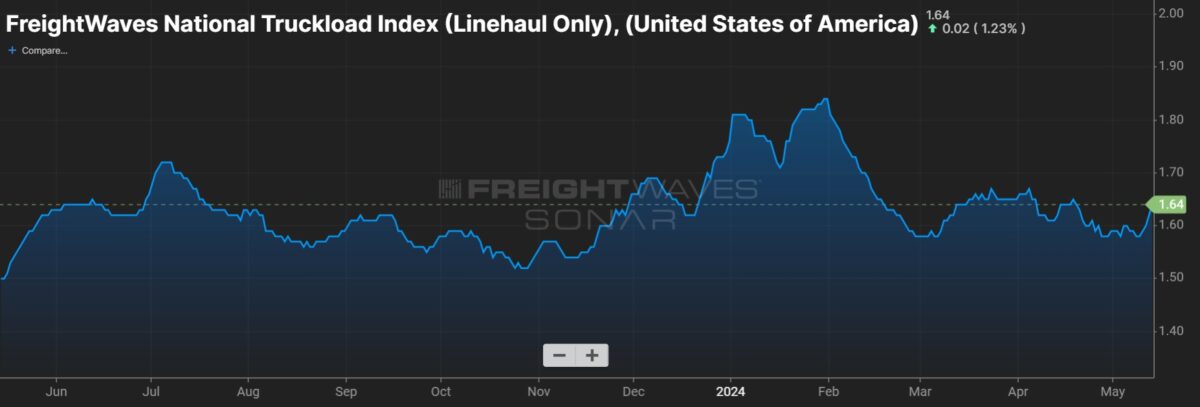Another month passed without signs a recovery in the freight cycle was on the horizon. “Still waiting for it,” Cass’ April update on volumes and pricing stated.
The shipments component of the Cass Freight Index fell again in the month, down 1.6% seasonally adjusted from March and 4% lower year over year (y/y). The Tuesday data showed volumes were hovering around the late 2023-January 2024 cycle trough. The April reading was the lowest since January, which is typically the slowest part of the year and weaker than normal this year due to severe winter storms.
A later Lunar New Year and the Baltimore bridge collapse were cited as detractors to demand during the month. The report also said additions to private fleets are negatively impacting results at the for-hire fleets.
“Private fleets are now more actively competing for spot freight to fill empty backhauls, lengthening below-trend for-hire demand levels,” the report said.
The y/y comparisons for the shipments index get easier in the coming months. The forecast is for the data set to decline 3% y/y in May. A prior forecast called for the index to turn positive by June, but that appears in jeopardy now.
| April 2024 | y/y | 2-year | m/m | m/m (SA) |
| Shipments | -4.0% | -6.3% | -1.3% | -1.6% |
| Expenditures | -16.8% | -28.4% | 0.0% | -1.9% |
| TL Linehaul Index | -3.8% | -15.6% | 0.1% | NM |
Cass’ expenditures index, which measures all dollars spent on freight including fuel surcharges and accessorial charges, fell 16.8% y/y in April and 1.9% from March on a seasonally adjusted basis. Backing out the decline in shipments implies rates were off 13% y/y in the month, which was the smallest decline in implied rates since last May.
The y/y comps also get easier this summer. The index is expected to decline 16% y/y in the first half of 2024 and 10% for the full year.
The Truckload Linehaul Index, which excludes changes in fuel and accessorial charges, declined 3.8% y/y but ticked 0.1% higher than the March reading.
The TL rate index includes both spot and contract freight. It has largely been flat for the past year.
“With spot rates steady over the past several months, downward pressure on the larger contract market is lessening, with some instances of contract rate increases bucking the downtrend recently,” the report said.
Schneider National (NYSE: SNDR) was the lone carrier to report improvement in contractual rate negotiations during the first-quarter earnings season. It said contract renewals turned positive in the period for the first time in six quarters, with pricing up by a low-single-digit percentage. However, it was also quick to say that it’s “not calling an inflection in the market” yet.
The linehaul index’s two-year-stacked comp (to April 2022) was down more than 15%, which was the biggest decline ever recorded in the data set.
“Goldilocks economic conditions of strong growth and disinflation are largely holding, a rising tide which eventually should lift all boats,” the report said. “But at the moment, the freight growth being generated by the economy is being handled by railroads and private fleets.”
Data used in the indexes is derived from freight bills paid by Cass Information Systems (NASDAQ: CASS), a provider of payment management solutions. Cass processes roughly $40 billion in freight payables annually on behalf of customers.









A MEL S
Notice how the large companies when asked, are quick to throw out luciferian lies about things are improving meanwhile, their revolving door of drivers quiting due to lack of freight <miles = <$$$.
I am getting foodstamp/ neighborhood car wash pay as a former owner operator turned company driver.
Trucking is a wreck today and has been for the pass two years (freight availability & rates) plus the ever increasing FMCSA rules Governing what we can't do or must do.
Hate I waited so long and overstayed my presence in thus trucking chaos.
Young Americans please stay away from this trick baby called trucking.
h man
It is getting much much worse. At this point im starting to think the conspiracy theorists are right about a full economic collapse.
Stephen Webster
We were all hoping for a improvement both in Canada and Mexico as well the United States. In Ont Canada I was at the truck world show and many drivers were looking to get out of trucking and lease and owner ops that were working for large trucking companies ( many who came to Canada in past 10 yrs ) when a number of trucking companies seen me 7 out of the 11 that I had talks with said we have too many cheap trucks one said a improvement would be nice and we need tiered hourly pay
3 of the companies and a senior person with a different news outlet all said we need more cheap foreign drivers to keep freight rates low and to control inflation despite all the companies closing and no affordable housing for their families. . Since then I have made it a pint to talk to as many drivers as possible and most are not happy and those under 35 are looking into a different line of work when this recession is over. Then will have a huge driver shortage of good quality drivers. Canada will have to even lower our low standards of the foreign drivers from lower wage countries to the point that the U S should limit trucks from Canada and the Mexico coming into United States in my opinion to reduce truck crashes